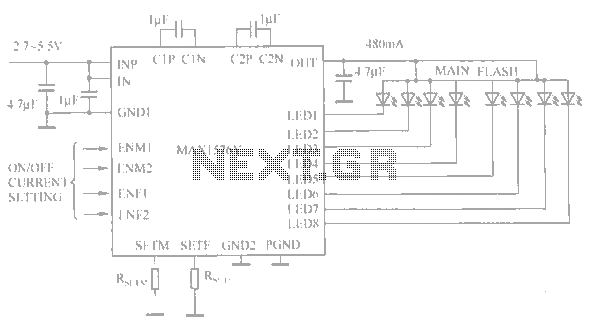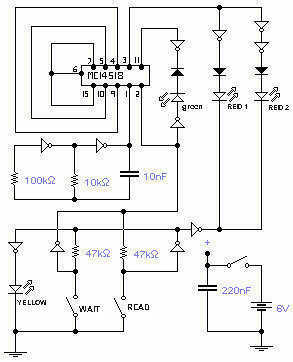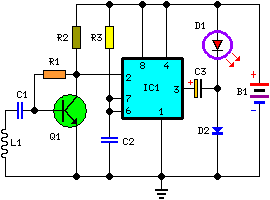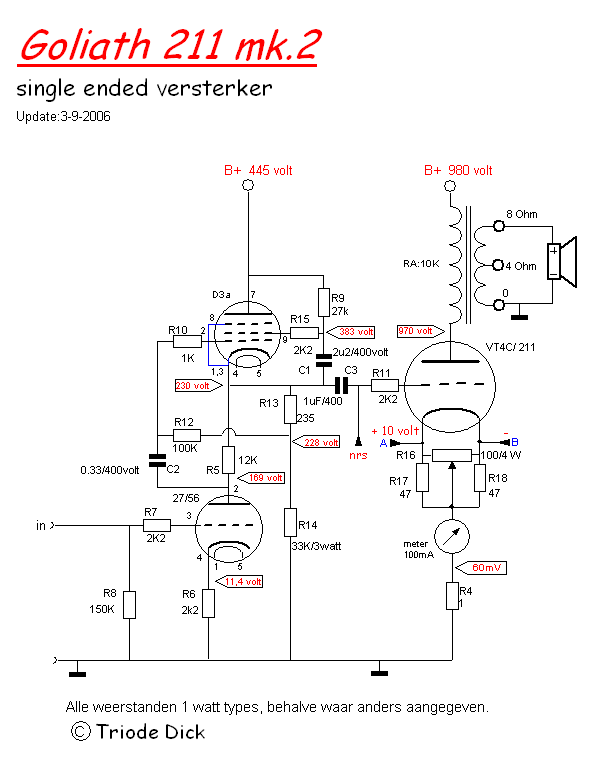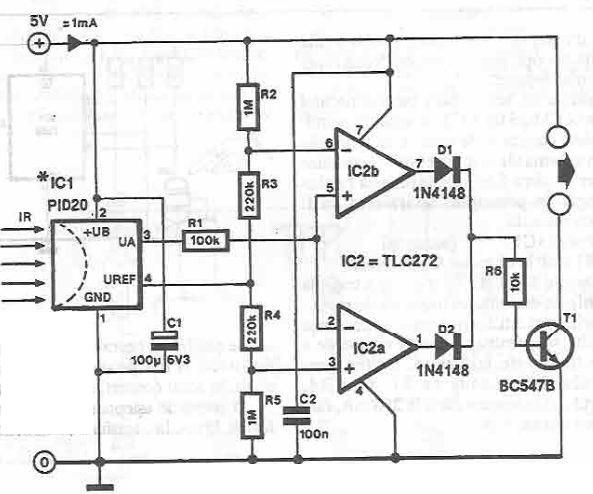
Whites Classic I metal detector schematic diagram
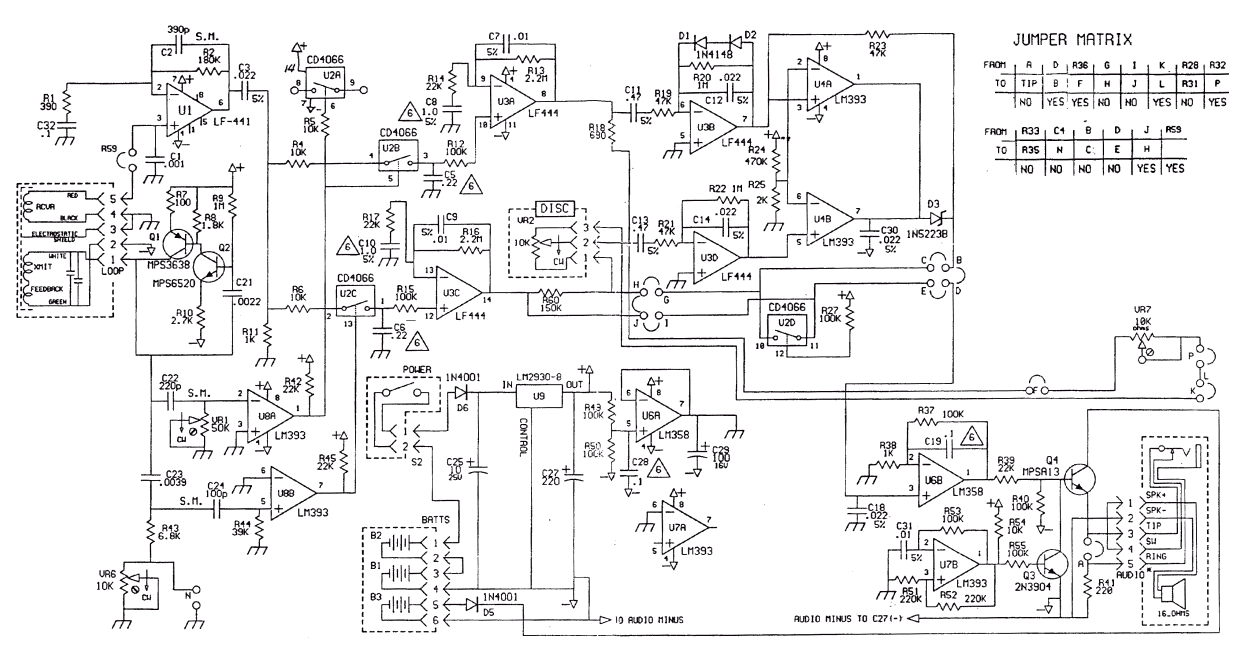
The White's Classic I was a straightforward and user-friendly metal detector, making it suitable for entry-level enthusiasts. It featured a simple design with only an on/off switch and a discriminator adjustment knob. Although it lacked depth, it was capable of detecting coins, jewelry, and relics when operated by a skilled user. Despite its effectiveness in its time, newer and more advanced beginner metal detectors are now available. The detector utilized four transistors (MPS3638, MPS6520, MPSA13, and 2N3904) along with several integrated circuits: a CD4066 digital switch, three LM393 dual comparators, LF444, LF441, LM358 operational amplifiers, and an LM2930-8 3-terminal positive voltage regulator. All resistors in the circuit were rated at 1/4 watt with a tolerance of +/- 5%, and all capacitors were specified in microfarads unless otherwise noted. Capacitors greater than 1 µF were aluminum electrolytic types, while those less than 1 µF were polyester film types. Capacitors marked with a triangle were of the stacked polyester variety. Areas enclosed by dashed lines were not part of the main printed circuit board (PCB).
The White's Classic I metal detector is designed as a basic yet effective tool for novice metal detecting enthusiasts. Its simplicity is a key feature, allowing users to quickly learn the fundamentals of metal detection without the complexities found in more advanced models. The operational framework is built around a minimalistic interface, which includes an on/off switch and a discriminator knob that enables users to filter out unwanted signals, thereby enhancing the detection of valuable items.
The circuit design incorporates four transistors, which are essential for signal amplification and processing. The MPS3638 and MPS6520 transistors function primarily in the signal path, while the MPSA13 and 2N3904 transistors may be utilized for switching and additional amplification tasks. The use of a CD4066 digital switch allows for effective control of signal routing within the detector, contributing to its overall functionality.
The three LM393 dual comparators serve as critical components for comparing input signals, facilitating effective discrimination between different types of metals based on their conductivity. This capability is crucial for users who wish to avoid false signals from unwanted metal objects. The operational amplifiers (LF444, LF441, and LM358) are employed for signal conditioning, ensuring that the signals processed by the detector are clean and accurately represent the detected objects.
Power regulation is managed by the LM2930-8, which provides a stable voltage supply necessary for the reliable operation of the detector's circuitry. The choice of 1/4 watt resistors with a +/- 5% tolerance ensures that the circuit operates within acceptable limits, while the specified capacitors are selected based on their capacitance values to optimize performance. The distinction between aluminum electrolytic and polyester film capacitors is significant, as it affects the frequency response and stability of the circuit.
In summary, the White's Classic I metal detector, while basic in its design, incorporates a thoughtful arrangement of components that allows it to perform effectively for entry-level users. Its straightforward operation, combined with reliable circuitry, makes it a valuable tool for those beginning their journey in metal detecting.The White`s Classic I was a very simple, easy to use machine, ideal for the entry-level detectorist to pick-up-and-go. It was a simple detector with no bells or whistles, only an on/off switch and a turn knob for a discriminator.
It did not have much depth but it did find coins, jewelry and relics in the hand of a skilled hobbyist. While the Class ic I was good for its day, there are now better beginner metal detectors on the market. The detector used 4 transistors (MPS3638, MPS6520, MPSA13 and 2N3904) and only a few ICs: a CD4066 digital switch, three LM393 dual comparators, LF444, LF441, LM358 op-amp ICs and an LM2930-8 3-terminal positive regulator. All resistors in the schematic are 1/4 watt, +/- 5% tolerance and all capacitors are in microfarads unless marked otherwise.
Capacitors greater then 1 uF are aluminum electrolytics. Capacitors less than 1uF are polyester film type. Capacitors marked with a triangle are stacked polyester type. Areas inside dashed lines are not located on the main PCB. 🔗 External reference
The White's Classic I metal detector is designed as a basic yet effective tool for novice metal detecting enthusiasts. Its simplicity is a key feature, allowing users to quickly learn the fundamentals of metal detection without the complexities found in more advanced models. The operational framework is built around a minimalistic interface, which includes an on/off switch and a discriminator knob that enables users to filter out unwanted signals, thereby enhancing the detection of valuable items.
The circuit design incorporates four transistors, which are essential for signal amplification and processing. The MPS3638 and MPS6520 transistors function primarily in the signal path, while the MPSA13 and 2N3904 transistors may be utilized for switching and additional amplification tasks. The use of a CD4066 digital switch allows for effective control of signal routing within the detector, contributing to its overall functionality.
The three LM393 dual comparators serve as critical components for comparing input signals, facilitating effective discrimination between different types of metals based on their conductivity. This capability is crucial for users who wish to avoid false signals from unwanted metal objects. The operational amplifiers (LF444, LF441, and LM358) are employed for signal conditioning, ensuring that the signals processed by the detector are clean and accurately represent the detected objects.
Power regulation is managed by the LM2930-8, which provides a stable voltage supply necessary for the reliable operation of the detector's circuitry. The choice of 1/4 watt resistors with a +/- 5% tolerance ensures that the circuit operates within acceptable limits, while the specified capacitors are selected based on their capacitance values to optimize performance. The distinction between aluminum electrolytic and polyester film capacitors is significant, as it affects the frequency response and stability of the circuit.
In summary, the White's Classic I metal detector, while basic in its design, incorporates a thoughtful arrangement of components that allows it to perform effectively for entry-level users. Its straightforward operation, combined with reliable circuitry, makes it a valuable tool for those beginning their journey in metal detecting.The White`s Classic I was a very simple, easy to use machine, ideal for the entry-level detectorist to pick-up-and-go. It was a simple detector with no bells or whistles, only an on/off switch and a turn knob for a discriminator.
It did not have much depth but it did find coins, jewelry and relics in the hand of a skilled hobbyist. While the Class ic I was good for its day, there are now better beginner metal detectors on the market. The detector used 4 transistors (MPS3638, MPS6520, MPSA13 and 2N3904) and only a few ICs: a CD4066 digital switch, three LM393 dual comparators, LF444, LF441, LM358 op-amp ICs and an LM2930-8 3-terminal positive regulator. All resistors in the schematic are 1/4 watt, +/- 5% tolerance and all capacitors are in microfarads unless marked otherwise.
Capacitors greater then 1 uF are aluminum electrolytics. Capacitors less than 1uF are polyester film type. Capacitors marked with a triangle are stacked polyester type. Areas inside dashed lines are not located on the main PCB. 🔗 External reference
